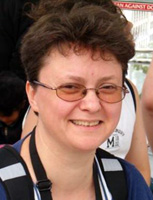Aleksandra Zaparucha provides a very detailed overview of the situation of CLIL in Poland covering the challenges being faced: CLIL at school and university levels and teacher training and development.
 |
Introduction | The situation today| University level| In the EU context| Government perspective| CLIL in Poland - a handful of facts| CLIL students and teachers| Training and teacher development| School experiences - websites
Introduction
The year 1989 brought profound changes to Poland: political, economic and social. None of the spheres of people's lives were left untouched including education and teaching languages. The dominant role of Russian, the only obligatory language at primary school and one of two obligatory languages at secondary, was abolished. Wherever they could find a more or less competent teacher, schools tried to introduce other languages instead of Russian. Thus, after years of limited choice of foreign languages taught at school, there came times when what was selected to be taught depended on what specialist there was, rather than on the students' needs or preferences. And, of course, no one thought of or heard of combined teaching of school subjects and languages.
The
situation
todaySince 1989 the situation has changed. Today, the dominant position of English is unquestioned, with Russian being just an option for the second or third language to choose from. However, recent governmental reports do not leave space for optimism. Today, the first foreign language is obligatory from primary 4, i.e. the age of 10. Younger classes are also taught languages, but this is not obligatory and depends on the schools' decision and their financial situation. As a result, Poland has the lowest percentage of children under 10 taking foreign language classes: 41%, a decrease of 4% if compared to the statistics a year or two ago. In countries like Denmark or the Netherlands this percentage well exceeds 90%. Another negative sign are this year's results in external high school leaving exam in English. The average level of the exam result was a mere 60%, while the exam can be passed if 30% of points are scored!
University
levelAnd how is it at the university level? My recent survey made among geography students and graduates throughout the country revealed the level and the number of classes is, in their opinion, generally too low, often without specialist vocabulary and specialist texts studied. Most universities do not offer foreign language teaching to the first year students and put an obligation to pass B2 level exam - the level which can be achieved in a few years' intensive learning. And the students often have 10 or more years of learning a foreign language, as they more and more often learn them outside formal school education. In fact, language schools are booming.
In the
EU
contextThe situation is serious as, according to Eurostat, only 29% of Poles declare they know English (with the EU average of 51%). And there is a growing cost to pay. Economists estimate that if the knowledge of English among Poles was at least at the EU average the economy would generate a staggering 70 billion euros extra annually! (M. Polak, 2008). There is a need for introducing English to all the levels of education, starting from kindergarten and finishing at the university level. It is also postulated that a real revolution would take place if English got the same status as Polish as the language used to teach school subjects (M. Polak, 2008). It is often called 'bilingual teaching' in Poland, rather than CLIL, but this is it - a suggestion to increase the amount of time foreign languages are taught by introducing it into a regular school practice during lessons other than languages.
Government
perspective
Now there arises a question whether the government, and the Ministry of Education especially, is doing anything with these reports? The recent decisions refer to the age when children start language education. It is planned to lower the age of obligatory foreign language education to the first class of primary schools, i.e. 6-year-olds. Moreover, the second language will be obligatory at junior high (the old two-tier system was changed into a three-tier system of education) not as late as high school as it is now. And the Ministry of Education is planning to introduce more rigorous rules regarding the percentage of points needed to pass school leaving exams, including languages. Another suggestion is to give up foreign films being dubbed in favour of subtitles as to let people hear the original dialogues in foreign languages.
CLIL in
Poland
- a handful of factsAll the above facts considered, there is a great pressure to learn foreign languages, mainly English. Due to demographics the number of students attending school is decreasing and schools therefore need to compete to attract the decreasing numbers of students. This is often done by offering a wider choice of languages to be studied and an innovative form of teaching and learning. As a result, classes and schools which integrate languages with school subjects are on the rise. The first bilingual classes appeared in public high schools in Poland in the school year 1991/92, while those in junior high school in 1999/2000. There are also a few primary school bilingual classes. Presently there are about a 100 schools which offer bilingual teaching (Co to jest…, undated). The leading languages are English and German, followed by French and a few examples of Spanish (eMPe, 2008). The choice of school subjects is often limited as there is lack of specialist teachers whose foreign language competencies are high enough to undertake such a task. What cannot be taught bilingually includes Polish language and another foreign language, which is not a surprise, but also Geography and History of Poland (Szkoly dwujezyczne…, undated), which is strange. The problem is Geography and History curricula often integrate a broader and international view with the national. Thus, teaching so as to avoid talking about Poland in a foreign language sounds inconsistent. Generally, at least two subjects have to be taught in this way to call the class bilingual (Szkoly dwujezyczne…, undated).
CLIL
students
and teachersStudents who wish to join bilingual classes either take an entrance test, which is often the case of English or German, or spend a year in class 'zero' on mastering the language, often the case of Spanish and French. Since 2005 all the subjects taught bilingually may also be taken during final high school leaving exams. Also the language exam itself is obligatory taken at a much higher level than after non-bilingual courses. In terms of the language competencies of the teachers the minimum qualification for them is Cambridge First Certificate. There is, alas, no obligation to complete any foreign language teaching courses. Materials used by the teachers range from original textbooks in a given language to magazine articles, websites and teacher-produced materials.
Training
and teacher developmentFor those interested in learning more on bilingualism and bilingual teaching there are, in fact, limited resources. However, an interesting e-course has recently been prepared by the National In-Service Teacher Training Centre in Warsaw for those who wish to start bilingual classes at their schools (Jakie kroki…, undated). It is a well-written step-by-step guide in Polish available via their website to all interested in introducing bilingual education to their schools, namely language teachers, subject teachers with good command of a foreign language and school administration. The course deals with the legal aspects of bilingual classes, practical hints regarding teaching staff and other organizational and financial aspects. Moreover, it offers help to all those who decide to undertake such a challenge.
In terms of postgraduate or in-service teacher training for those who wish to get involved in bilingual teaching there are some courses available, although the offer is limited. One of those which can be found on the Internet is a Postgraduate Course organized in Lódz in December 2008 by the English section of the Language Teacher Training College in Worclaw. It is addressed to subject specialists whose level of English is adequate for bilingual teaching. Another institution which offers workshops to subject specialists is the National Centre for Further Training of Geography Teachers in Torun. In October 2008 the centre is holding the second session for Geographers teaching their subject through English, and possibly next year it is going to hold such an event devoted solely to teaching History through English.
School experiences -
websites
What is available over the Internet is a wide selection of school websites which present their own experience with bilingual teaching. For instance, the Bilingual Junior High School number 49 and the High School number 14 in Wroclaw have introduced bilingual teaching in English (Metody i sposoby…, undated). The High School number 13 in Lódz offers bilingual classes in French (Co to jest…, undated), while the High School number 7 and the Bilingual Junior High School in Poznan use German and the language of bilingual instruction (Klasa dwujezyczna…, undated). Looking at such websites would be very useful to get the first-hand insight of what bilingual education really means in Poland.
- Co to jest dwujezycznosc? 10.12.2006. na podstawie Edukacja dwujezyczna, Uniwersytet Warszawski, Warszawa 2002, materialy z konferencji poswieconej dwujezycznosci http://www.dw13lo.edu.pl/content/view/45/35/
- Co to jest dwujezycznosc? XIII LO w Lodzi; sekcja dwujezyczna z jezykiem francuskim
http://www.dw13lo.edu.pl/content/view/45/35/ - eMPe, Zalety nauczania dwujezycznego w szkole12.07.2008.
http://www.wykop.pl/ramka/78174/zalety-nauczania-dwujezycznego-w-szkole - Jakie kroki nalezy podjac aby zalozyc oddzial dwujezyczny? Aspekty prawne, merytoryczne i praktyczne" Centralny Osrodek Doskonalenia Nauczycieli
http://www.e-learning.codn.edu.pl/szkolenia/szkolenie3 - Klasa dwujezyczna polsko-niemiecka, Poznan VII LO i Gimnazjum Dwujezyczne 'Dabrówka'
http://dabrowka.poznan.pl/index.php?option=com_content&task=view&id=21&Itemid=34 - Metody i sposoby nauczania w klasach dwujezycznych w GD nr 49 oraz LO nr 14 we Wroclawiu http://www.lo14.wroc.pl/cup/94104a0b-c6d5-4483-a29d-6f70497c9c5c/130.aspx
- Polak M., Nieznajomosc prawa szkodzi, a jezyków obcych kosztuje 14.07.2008.
http://www.wykop.pl/ramka/78174/zalety-nauczania-dwujezycznego-w-szkole - Przygotowanie nauczycieli do nauczania bilingwalnego, Pracownia Doskonalenia Nauczycieli Jezyków Obcych, Wroclaw
http://edukacja.money.pl/ksztalcenie;bilingwalne;przygotowanie;do;nauczania;przedmiotu;w;jezyku;obcym,lodz,oferta,80124,e.html
Bilingual education remains a real challenge for all the parties involved - the teachers, the students and the school administration alike.
Aleksandra Zaparucha
olazap@wp.pl
Your perspectives

Read about CLIL teachers' experiences around the world! Some of the letters provide an overview of the situation for CLIL teachers in individual countries, and some give a more detailed look at teaching.
- 1
- 2
- 3
- 4
- 5
- 6
- 7
- 8
- 9
- 10
- 11
- 12
- 13
- 14
- 15
- 16
- 17
- 18
- 19
- 20
- 21
- 22
- Currently reading
CLIL in Poland: A Real Challenge



No comments yet